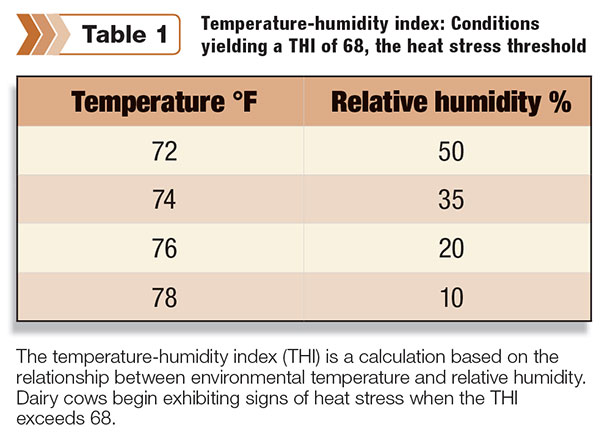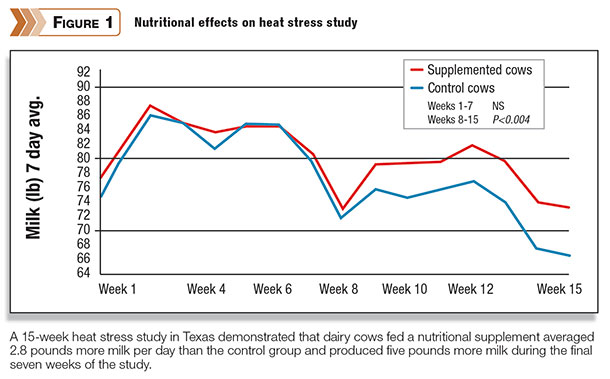Dairy cattle face numerous sources of stress, expected and unexpected, throughout their life cycle. One of the most predictable is heat stress, which can compromise cow health and production, both of which can have a significant economic impact on the profitability of a dairy. The effects of heat stress are estimated to cost the dairy industry up to $1.5 billion annually. Primary economic losses may include lower milk yields, reduced reproductive efficiency and even death.
The onset of heat stress in dairy cattle has been defined as the point at which rectal temperature exceeds 101.3ºF and respiration rate exceeds 60 breaths per minute.
Dairy cows begin to exhibit these signs when the ambient temperature exceeds 77ºF or when the Temperature-Humidity Index (THI) – a calculation based on the relationship between environmental temperature and relative humidity – exceeds 68 ( Table 1 ).

At those points, cows will display increased respiration rates and open-mouth panting. These behaviors are usually followed by a reduction in dry matter intake and subsequent decline in milk yields. Severe heat stress occurs when the THI exceeds 90.
Although dairy producers utilize various housing, management and nutritional strategies designed to alleviate the effects of heat stress on production, cow health can still be compromised. Higher-producing cows are particularly at risk since they generate more heat while eating more feed to support higher levels of production.
Acute exposure to high environmental temperatures has been shown to cause significant increases in blood concentrations of the stress hormone cortisol. It is well documented that cortisol suppresses immune function in dairy cows, increasing susceptibility to costly diseases such as mastitis and metritis.
These diseases can lead to the onset of others, all contributing to increased treatment costs, lower milk production and increased culling rates.
Nutritional strategies for managing heat stress
Dairy cows in the southern and western U.S. are affected by heat stress for a significant part of the year. In a 15-week study, from July to October 2012, a trial was conducted at a commercial dairy in Texas to evaluate the impact of a feeding strategy on milk production since reduced milk yield is one of the most measurable responses to heat stress. Dry matter intake and body condition also were evaluated.
The study involved 266 mid-lactation, high-producing, multiparous, Jersey-Holstein crossbred commercial cows. All study cows were housed in a freestall barn equipped with fans and sprinklers, milked three times a day through a rotary parlor and fed a one-group TMR consisting of a corn silage/commodity grain diet.
One group received a nutritional supplement designed to support immune function (OmniGen-AF from Prince Agri Products), while control cows were not supplemented.
During the first seven weeks of the study, high daytime temperatures averaged higher than 90 degrees.
Field study results
As shown in Figure 1 , the Texas study demonstrated that cows fed the nutritional supplement produced more milk than the control group. Supplemented cows:
- Averaged 2.8 pounds more milk per day than the control group during the 15-week trial period
- Produced 5 pounds more milk during the final seven weeks of the study

Results further demonstrated that early lactation cows (120 days or less in milk) that received the supplemented diet produced 3.6 pounds more milk during the first seven weeks compared to early lactation control cows, and 6.4 pounds more milk during weeks 8 through 15.
Results of the Texas dairy study are being presented at the 2014 American Dairy Science Association (ADSA) annual meeting being held July 20-24 in Kansas City, Missouri.
A previous study conducted at the University of Arizona also demonstrated the role of the nutritional supplement on immune function in helping to protect dairy cattle from the adverse effects of heat stress.
In that study, cows were housed in a controlled environment and fed the same nutritional supplement used in the Texas study. In the Arizona study, cows were pre-fed the nutritional supplement for 52 days prior to heat stress as well as during the 10-day heat stress period.
During heat stress, the supplemented cows had significantly greater dry matter intakes, reduced respiration rates and lower rectal temperatures. Somatic cell counts also were observed to be lower in the supplemented cows particularly during the post-heat stress recovery period.
Other nutritional strategies
In addition to supporting immune function, other nutritional strategies can be employed to help dairy cows better tolerate a hot environment.
This includes modifying the diet to include high-quality forages and increasing energy density through the addition of high-fat feed or bypass fats, or by utilizing lower-fiber feedstuffs. These modifications help reduce the heat of digestion and overcome decreases in dry matter intake during hot weather.
In addition, providing an adequate source of cool, fresh water is particularly important during periods of heat stress since water accounts for more than 85 percent of milk content. Dairy cows will increase water intake by as much as 50 percent as temperatures reach the mid-90s.
Heat stress effects on other groups
Although calves, heifers and dry cows don’t experience the demands of milk production, they also can be negatively affected by heat stress. Dairy producers should take appropriate steps to manage heat stress for these groups, including providing plenty of fresh water, shade and ventilation.
Heat stress is a recurring risk in all parts of the country that is costly to dairy producers in terms of health disorders and lost production. Managing heat stress through nutrition and cow comfort can help produce healthy cows that are more productive, more resistant to disease and more profitable. PD
Jim Chapman, Ph.D., PAS, is the director of research, development and technical services for Prince Agri Products, Inc. He specializes in field trials and institutional research, product testing and development, and technical support.
References omitted due to space and are available upon request. Click here to email an editor.

Jim Chapman
Director of R&D and Technical Services
Prince Agri Products, Inc.





